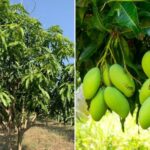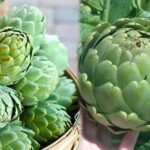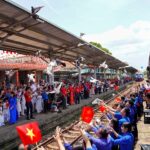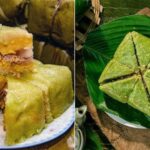A Cultural Heritage in the Heart of the Delta
Nẽ Market, located in Từ Châu village, Hòa Bình commune, Vũ Thư district, Thái Bình province, stands out as a unique cultural phenomenon. Unlike thousands of traditional markets across Northern Vietnam, Nẽ Market convenes only once a year, specifically on the morning of the second day of the Lunar New Year. This extraordinary market is not just a place for trading but also a cultural and spiritual destination, attracting tens of thousands of visitors annually.
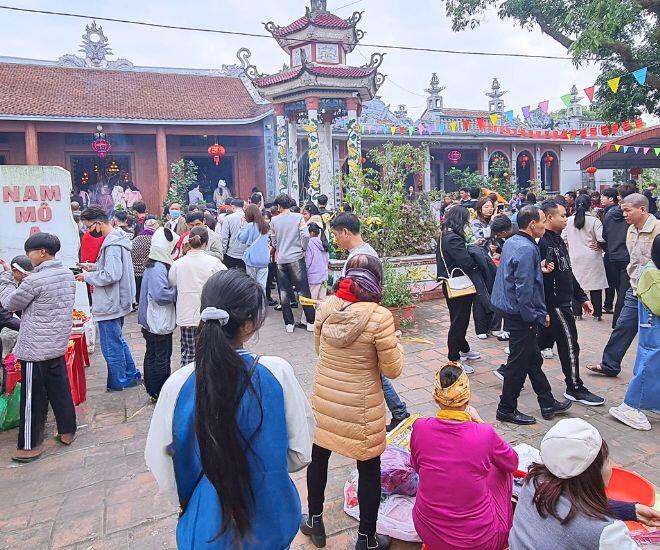
Situated about 5 kilometers southeast of Vũ Thư town center, Nẽ Market is nestled within the sacred grounds of Nẽ Temple, an ancient temple with a history spanning over 300 years, dating back to the Later Lê dynasty. The rare combination of a religious space and commercial activities creates a distinctive cultural phenomenon in the rural life of Vietnam.
According to the narratives of the village elders, Nẽ Market emerged in the 18th century, linked to the legend of the founding monk of Nẽ Temple. Initially, it served as a small-scale exchange venue for local agricultural products, eventually evolving into a new year market imbued with spiritual and cultural significance.
Salt and Rice: Symbols of Abundance
The most distinctive feature of Nẽ Market lies in the extreme simplification of its product offerings. Unlike typical markets bustling with a variety of goods, Nẽ Market focuses solely on two main products: sea salt and glutinous rice, both fundamental foodstuffs in Vietnamese agriculture and emblematic of the essence of folk culture.

Each packet of salt at Nẽ Market is carefully wrapped in fresh banana leaves and tied with traditional rattan strings. Beyond its role as a condiment, salt here carries profound spiritual significance, symbolizing the endurance and warmth of family bonds and life itself. In folk belief, buying salt at the beginning of the year brings good fortune and prosperity throughout the year.
Glutinous rice, the second indispensable product at Nẽ Market, is a specialty of the flooded plains of Thái Bình. These immaculate, fragrant grains are meticulously selected by locals, embodying the aspirations for a year of abundance and contentment. The proverb, “Buy salt at the beginning of the year, and buy lime at the end,” has been ingrained in the consciousness of generations of Vietnamese, shaping the unique character of Nẽ Market across the centuries.
A Unique Trading Culture: No Haggling, No Bargaining
While haggling and bargaining are commonplace in traditional markets, Nẽ Market stands apart with its solemn and peaceful atmosphere, characterized by a unique trading ritual: no verbal negotiations, no haggling over prices.
The buying and selling at Nẽ Market follow a simple yet meaningful protocol: buyers silently place money into the bamboo baskets of the sellers, with the amount left entirely to their discretion. As shared by Ms. Nguyễn Thị Thích, a long-time salt seller mentioned in the document, “Lucky money at the beginning of the year represents goodwill, and whether it’s a small or large amount, it brings joy to both parties.” This custom reflects the Vietnamese philosophy of “giving to bring good fortune to others” and demonstrates the mutual respect and goodwill between buyers and sellers.
Absent are the sounds of bargaining or calculations; instead, Nẽ Market unfolds in a serene atmosphere, akin to a spring ritual rather than a commercial activity. The market operates with a solemnity befitting the first day of the new year, markedly different from the lively trading atmosphere of typical markets.
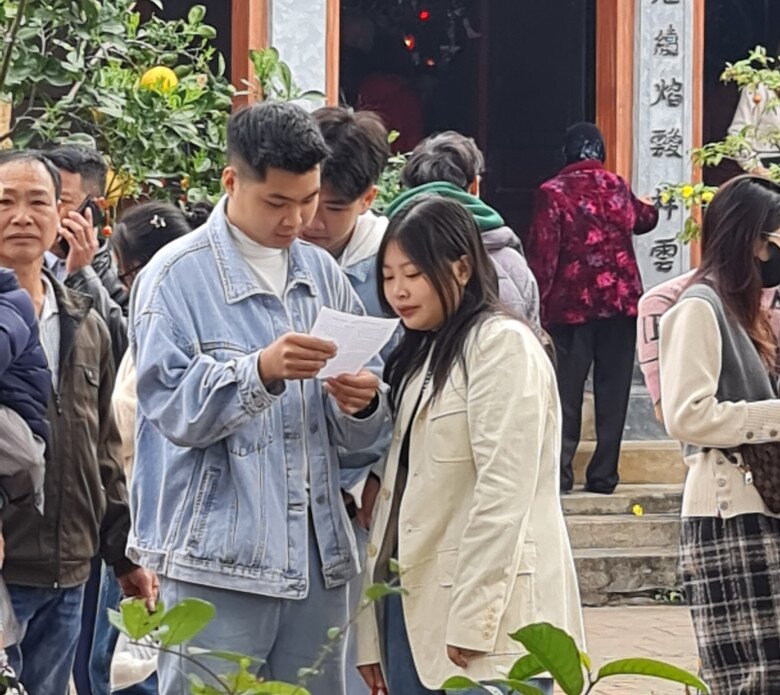
Visitors to Nẽ Market are not merely there to shop; they immerse themselves in a multidimensional cultural and spiritual experience. Nẽ Temple, with its ancient “Đinh” character architecture, curved roof tiles, and 18th-century wooden Buddha statues, serves as the architectural highlight of the area. As mentioned in the document, many families perform the ritual of praying for peace at the temple and practice the traditional custom of “xông đất” (entering a house for the first time in the new year), using salt to ward off evil spirits by lightly sprinkling it around the house.
Nẽ Market also serves as a community cultural exchange space, a gathering place for multiple generations, especially for those returning to their hometown to reconnect with their roots. Folk games such as “ném cầu” (throwing a ball through a ring) and “đi cà kheo” (walking on stilts) are organized around the temple grounds, creating a vibrant and authentic village festival atmosphere.
As mentioned in the document, Nẽ Market is also known as a “love market,” where young couples meet and exchange bundles of salt, symbolizing the strength of their bond.
Promoting Tourism While Preserving Heritage
Despite social changes, Nẽ Market has preserved its unique character for centuries. In recent years, the market has attracted increasing attention from domestic and international tourists. In 2024, the market recorded a remarkable turnout, welcoming over 15,000 visitors, 30% of whom were international guests—an impressive figure for a market that operates for only a few hours.
Recognizing the market’s unique value, local authorities are collaborating with the tourism sector to develop “Experience Traditional Tet” tours that include a visit to Nẽ Market and nearby historical sites. However, the increase in visitor numbers also presents challenges in preserving the architectural heritage of Nẽ Temple and maintaining the market’s authenticity.
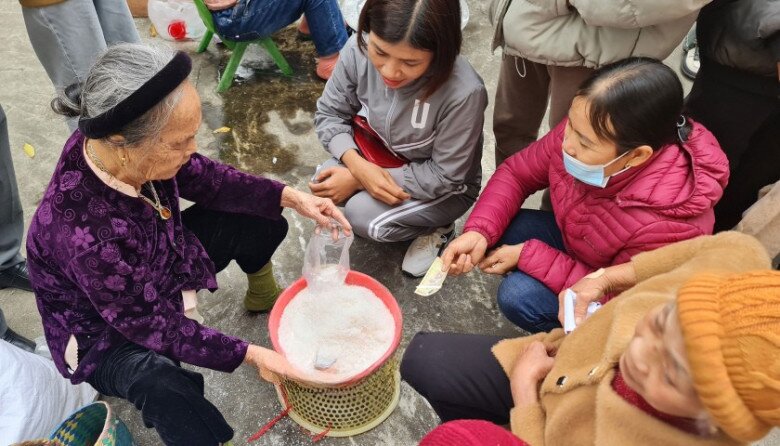
Measures such as visitor routing and the reduction of plastic use are being implemented to minimize negative impacts on the environment and traditional cultural space. Notably, the “Nẽ Market Digital Museum” project, which utilizes 3D technology to preserve the market’s imagery, is currently in the experimental phase, offering promising prospects for conserving and promoting this unique cultural asset globally.
Tips for Visiting Nẽ Market
For those eager to immerse themselves in the singular atmosphere of Nẽ Market, several important considerations are provided below to ensure a culturally immersive experience.
As advised, visitors should arrive at the market between 5 and 7 am to fully embrace the unique new year atmosphere. Traditional áo dài (Vietnamese long dress) or modest attire is recommended when entering the temple premises.
When shopping at the market, it is advisable to carry small-denomination banknotes (VND 10,000–50,000) for the “lucky money” tradition. According to folk wisdom, salt with evenly sized, unclumped grains is believed to bring greater fortune. Visitors are encouraged to select salt wrapped in fresh banana leaves, symbolizing reunion and harmony.
When receiving the salt, money should be placed in the basket respectfully, avoiding throwing or bargaining, as this demonstrates respect for the age-old customs of the market.
“Should You Plant a Mango Tree in Your Front Yard?”
The mango tree has long been an integral part of Vietnamese culture and lifestyle, offering not just economic and culinary value but also holding deep symbolic significance in feng shui. Is it auspicious to plant a mango tree in front of your house? Let’s delve into this intriguing question and uncover the answers within.
The World’s Fiber-Richest Vegetable, Recognized by the US: Abundant in Vietnam, Yet Underappreciated.
“The humble beetroot is a powerhouse of nutrients and is touted as the world’s richest source of nitrate. This vibrant vegetable is widely cultivated and consumed in Vietnam, with over a thousand varieties grown across the country. From vibrant purple roots to vibrant green leaves, beetroots are a versatile ingredient in the kitchen and a nutritional powerhouse. Read on as we uncover the secrets of this superfood and explore why it’s a staple in Vietnamese cuisine and traditional medicine.”

























